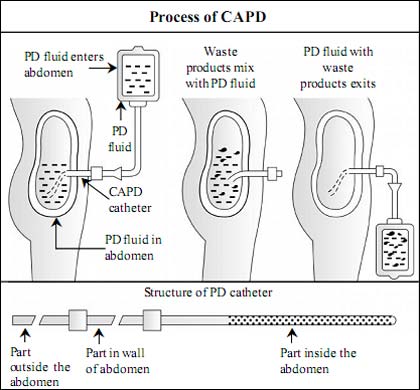74. Save Your Kidneys
2. Continuous Ambulatory Peritoneal Dialysis (CAPD) What is CAPD?
CAPD means :
C – Continuous: The process is uninterrupted (treatment without stopping for 24 hours a day, 7 days a week).
A – Ambulatory: The patient can walk around and performroutine activities.
P – Peritoneal: The peritoneal membrane in the abdomen works as a filter.
D – Dialysis: The method of purification of blood.
Continuous Ambulatory Peritoneal Dialysis (CAPD) is a form of dialysis which can be carried out by a person at home without the use of a machine. As CAPD provides convenience and independence it is a popular dialysis modality in many countries.
Process of CAPD :
CAPD catheter:The permanent access for peritoneal dialysis (CAPD catheter) is a soft thin flexible silicon rubber tube with numerous side holes. It is surgically inserted into the patient’s abdomen through the abdominal wall, about an inch below and to the side of the navel or belly button. The CAPD catheter is inserted about 10 to 14 days before CAPD starts. The PD catheter is the “life line” of CAPD patients, just as the AV fistula is to a patient on hemodialysis.
Technique of continuous ambulatory peritoneal dialysis (CAPD):
In CAPD, special fluid (dialysate) is infused into the abdominal cavity and is kept there for a period of time, after which it is drained. This process of fill, dwell and drain is called an exchange.
CHP. 13. Dialysis 75.
 Fill: Peritoneal dialysis fluid from the sterile PD bag is infused by gravity, through sterile tubings connected to the PD catheter, into the abdominal cavity. Usually, 2 liters of fluid is infused. The bag emptied of PD fluid is rolled up and tucked in the patient’s inner wear until the next exchange.
Fill: Peritoneal dialysis fluid from the sterile PD bag is infused by gravity, through sterile tubings connected to the PD catheter, into the abdominal cavity. Usually, 2 liters of fluid is infused. The bag emptied of PD fluid is rolled up and tucked in the patient’s inner wear until the next exchange.
Dwell: The period of time in which PD fluid remains inside the abdominal cavity is called the dwell time. This lasts for about 4 to 6 hours per exchange during the day and 6 to 8 hours at night. The process of cleaning the blood takes place during dwell time. The peritoneal membrane works like a filter allowing waste products, unwanted substances and excess fluid to pass from blood into the PD fluid. The patient is free to walk around during this time (hence the term, ambulatory).
Drain:When the dwell time is completed, the PD fluid is drained into the empty collection bag (which had been rolled up and tucked in the patient’s inner clothing). The bag with the drained fluid is weighed and discarded; the weight is recorded. The drained fluid should be clear. Drainage and replacement with fresh solution takes about 30 to 40 minutes. Exchanges may be done from 3 to 5 times during the day and once during the night. Fluid for the night exchange is left in the abdomen overnight and drained in the morning. Strict aseptic precautions should be observed when performing CAPD.
CAPD must be carried out meticulously every day at a fixed time with no holidays.